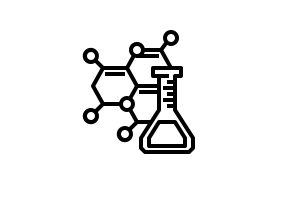Molecule:100799
From ChemWiki
Revision as of 16:54, 27 February 2024 by Victor.larignon (talk | contribs) (Undo revision 6964 by 127.0.0.1 (talk))
 molecule
molecule
Jump to:navigation, search
| Properties | |
|---|---|
| CID | n/a |
| CAS | n/a |
| IUPAC-Name | n/a |
| Abbreviation | n/a |
| Trivialname | n/a |
| Exact mass | 771.19125781236 |
| Molecular formula | C36H51CoCuN5S3+4 |
| LogP | n/a |
| Has vendors | n/a |
| Molecular role | n/a |
| Synonyms | n/a |

Click here to copy MOL-file.
Click here to show SMILES and InChI.
| InChI | 1S/C36H51N5S3.Co.Cu/c1-4-31-22-34(7-1)28-42-19-16-41-17-20-43-29-35-8-2-5-32(23-35)26-38-11-14-40(13-10-37-25-31)15-12-39-27-33-6-3-9-36(24-33)30-44-21-18-41;;/h1-9,22-24,37-39H,10-21,25-30H2;;/q;+2;+1 |
| InChI-Key | LHOOHFHVSCYQHJ-UHFFFAOYSA-N |
| SMILES | N123CCS4CC5C=C(CN6[Co+2]78N9CC%10C=C(C=CC=%10)CS([Cu+]14S(CC1C=CC=C(CN7CCN8(CC6)CC9)C=1)CC2)CC3)C=CC=5 |
Molecule is used on following pages
publication
investigation
Molecule roles
| Investigation type | Catalyst |
|---|---|
| Photocatalytic CO2 conversion experiments |

|
| Cyclic Voltammetry experiments |  |
| Absorption Emission Spectroscopy experiments |  |
| Ultraviolett Visuell experiments |  |
Records for role ""
Retrieved from "https://chemwiki.scc.kit.edu/main/mediawiki/index.php?title=Molecule:100799&oldid=6967"


topic
publication
investigation
molecule
Topics
no subcategories
no subcategories
- A Cu(I) Co(II) cryptate for the visible light-driven reduction of CO2
- A Dinuclear Cobalt Cryptate as a Homogeneous Photocatalyst for Highly Selective and Efficient Visible-Light Driven CO2 Reduction to CO in CH3CN-H2O Solution
- A Water Soluble Cobalt(II) Complex with 1,10‑Phenanthroline, a Catalyst for Visible‑Light‑Driven Reduction of CO2 to CO with High Selectivity
- A molecular noble metal-free system for efficient visible light-driven reduction of CO2 to CO
- An earth-abundant system for light-driven CO2 reduction to CO using a pyridinophane iron catalyst
- An integrated Re(I) photocatalyst and sensitizer that activates the formation of formic acid from reduction of CO2
- Carbon dioxide reduction via light activation of a ruthenium–Ni(cyclam) complex
- Chirdon-et-al-2016-tuning-iridium-photocatalysts-and-light-irradiation-for-enhanced-co2-reduction.pdf
- Copper(ii) tetrakis(pentafluorophenyl)porphyrin: highly active copper-based molecular catalysts for electrochemical CO2 reduction
- Dinuclear Metal Synergistic Catalysis Boosts Photochemical CO2-to-CO Conversion
- Durable Solar-Powered Systems with Ni-Catalysts for Conversion of CO2 or CO to CH4
- Efficient Visible-Light-Driven Carbon Dioxide Reduction using a Bioinspired Nickel Molecular Catalyst
- Exchange Coupling Determines Metal-Dependent Efficiency for Iron- and Cobalt-Catalyzed Photochemical CO2 Reduction
- Exploring the Full Potential of Photocatalytic Carbon Dioxide Reduction Using a Dinuclear Re2Cl2 Complex Assisted by Various Photosensitizers
- Function-Integrated Ru Catalyst for Photochemical CO2 Reduction
- Highly Efficient and Robust Photocatalytic Systems for CO2 Reduction Consisting of a Cu(I) Photosensitizer and Mn(I) Catalysts
- Highly Efficient and Selective Photocatalytic CO2 Reduction by Iron and Cobalt Quaterpyridine Complexes
- Highly efficient and selective visible-light driven CO2-to-CO conversion by a Co-based cryptate in H2O-CH3CN solution
- Ir(tpy)(bpy)Cl as a Photocatalyst for CO2 Reduction under Visible-Light Irradiation
- Light-Driven Reduction of CO2 to CO in Water with a Cobalt Molecular Catalyst and an Organic Sensitizer
- Merging an organic TADF photosensitizer and a simple terpyridine–Fe(iii) complex for photocatalytic CO2 reduction
- Metal-free reduction of CO2 to formate using a photochemical organohydride-catalyst recycling strategy
- Mn-carbonyl molecular catalysts containing a redox-active phenanthroline-5,6-dione for selective electro- and photoreduction of CO2 to CO or HCOOH
- Molecular Catalysis of the Electrochemical and Photochemical Reduction of CO2 with Earth-Abundant Metal Complexes. Selective Production of CO vs HCOOH by Switching of the Metal Center
- New Photosensitizers Based on Heteroleptic Cu(I) Complexes and CO2 Photocatalytic Reduction with (Ni(II)(cyclam))Cl2
- Nickel(II) pincer complexes demonstrate that the remote substituent controls catalytic carbon dioxide reduction
- Phenoxazine-Sensitized CO2-to-CO Reduction with an Iron Porphyrin Catalyst: A Redox Properties-Catalytic Performance Study
- Photocatalytic CO2 Reduction Mediated by Electron Transfer via the Excited Triplet State of Zn(II) Porphyrin
- Photocatalytic CO2 Reduction Using a Robust Multifunctional Iridium Complex toward the Selective Formation of Formic Acid
- Photocatalytic CO2 Reduction under Visible-Light Irradiation by Ruthenium CNC Pincer Complexes
- Photocatalytic CO2 reduction using a Mn complex as a catalyst
- Photocatalytic CO2 reduction with aminoanthraquinone organic dyes
- Photocatalytic Carbon Dioxide Reduction Using Nickel Complexes as Catalysts
- Photocatalytic Reduction of CO2 by Highly Efficient Homogeneous FeII Catalyst based on 2,6-Bis(1’,2’,3’-triazolyl-methyl)pyridine. Comparison with Analogues.
- Photocatalytic Reduction of Carbon Dioxide to CO and HCO2H Using fac-Mn(CN)(bpy)(CO)3
- Photochemical CO2 Reduction Driven by Water-Soluble Copper(I) Photosensitizer with the Catalysis Accelerated by Multi-Electron Chargeable Cobalt Porphyrin
- Photochemical CO2 reduction with mononuclear and dinuclear rhenium catalysts bearing a pendant anthracene chromophore
- Photochemical Reduction of Carbon Dioxide to Formic Acid using Ruthenium(II)-Based Catalysts and Visible Light
- Photochemical reduction of carbon dioxide to formic acid
- Product Control in Visible-Light-Driven CO2 Reduction by Switching Metal Centers of Binuclear Catalysts
- Promoting photocatalytic CO2 reduction with a molecular copper purpurin chromophore
- Pyranopterin Related Dithiolene Molybdenum Complexes as Homogeneous Catalysts for CO2 Photoreduction
- Recent Advances on Metalloporphyrin-Based Materials for Visible-Light-Driven CO2 Reduction
- Rhenium(I) trinuclear rings as highly efficient redox photosensitizers for photocatalytic CO2 reduction
- Selective and Efficient Photocatalytic CO2 Reduction to CO Using Visible Light and an Iron-Based Homogeneous Catalyst
- Test
- Test-Page for Authors
- Test2-Nicole
- Toward Visible-Light Photochemical CO2‑to-CH4 Conversion in Aqueous Solutions Using Sensitized Molecular Catalysis
- Visible light driven reduction of CO2 catalyzed by an abundant manganese catalyst with zinc porphyrin photosensitizer
- Visible-Light Photocatalytic Conversion of Carbon Dioxide by Ni(II) Complexes with N4S2 Coordination: Highly Efficient and Selective Production of Formate
- Visible-Light Photocatalytic Reduction of CO2 to Formic Acid with a Ru Catalyst Supported by N,N’- Bis(diphenylphosphino)-2,6-diaminopyridine Ligands
- Visible-Light Photoredox Catalysis: Selective Reduction of Carbon Dioxide to Carbon Monoxide by a Nickel N-Heterocyclic Carbene–Isoquinoline Complex
- Visible-Light-Driven Conversion of CO2 to CH4 with an Organic Sensitizer and an Iron Porphyrin Catalyst
- Visible-Light-Driven Photocatalytic CO2 Reduction by a Ni(II) Complex Bearing a Bioinspired Tetradentate Ligand for Selective CO Production
- Visible-light-driven methane formation from CO2 with a molecular iron catalyst
- Water-Assisted Highly Efficient Photocatalytic Reduction of CO2 to CO with Noble Metal-Free Bis(terpyridine)iron(II) Complexes and an Organic Photosensitizer
- Why Slot Online Is the Ultimate Gaming Experience
none
Navigation